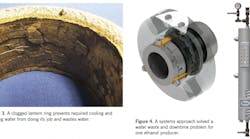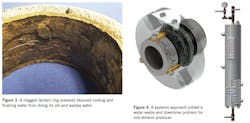In this article:
- 1. Precision installation of the ideal packing
- 2. Precision installation of the ideal mechanical seal
- 3. Appropriate flush arrangement and ideal barrier/flush fluid
- 4. Packing maintenance and reloading with the gland over time
- 5. Add a shaft-stabilizing bushing
- Case studies
The need to be green in every industry and support sustainable operations will only grow moving into 2022 and beyond. Green initiatives and environmental stewardship in the process industries begin with decreasing wasted water, which leads to decreased energy use.
Water leakage and loss may occur in many areas of process plants. One area with the potential to leak water is the stuffing box or seal chamber. This area may seem like a small amount of loss, but we will discuss water-saving procedures and best practices that prevent millions of gallons of waste per year. Focusing on five areas may help prevent this loss, decrease energy, and maximize equipment uptime.
Any rotating asset has a stuffing box, also called a seal chamber. These equipment types include:
- centrifugal pumps
- mixers
- agitators
- screw conveyors.
Within a stuffing box, many sources of unnecessary water waste exist, such as:
- excess stuffing box leakage
- shaft deflection
- blocked lantern ring
- damaged or worn shafts/sleeves
- process dilution
- seal chamber evaporation.
The following five general guidelines may help conserve water and save energy.
1. Precision installation of the ideal packing
In addition to water conservation, selecting the ideal packing and installing it correctly provides many other benefits. These include longer packing and equipment life, minimized shaft wear, cooler operation, and decreased process fluid dilution.
If packing is not seated properly in the stuffing box, packing wear is accelerated and water leakage increases. Proper seating and precision installation require tools that ensure the first packing ring sits square in the bottom of the stuffing box.
To ensure proper seating, use a split bushing or a tamping tool (see Figure 1). Never use a screwdriver or sharp tool, which will damage the packing and open leak paths. Correct seating helps ensure radial expansion. Each ring joint must be staggered by 90 degrees.
2. Precision installation of the ideal mechanical seal
Selecting the ideal seal for an application is important. Ensuring that the materials of construction are compatible with the process fluid and barrier fluid are critical. In addition, proper installation of the seal and setup of its environmental controls and barrier fluid system are just as important.
A cartridge seal simplifies installation, especially if your team is not fluent in seal installation. Selecting a vendor who provides training or assistance in installation is beneficial (see Figure 2). With training, the plant team will be able to carry out the next installation. While a cartridge setup may help the team install the seal correctly, they may need assistance from a sealing expert when setting up the environmental controls.
3. Appropriate flush arrangement and ideal barrier/flush fluid
Compression packing or a mechanical seal requires a cool, clean operating environment for success. To make sure the surroundings are appropriate, the following conditions must be met:
- The correct environmental control arrangement is selected.
- Ensure that the ideal flush/barrier fluid is used. Water or process fluid may not be robust enough.
- Properly set up and install the environmental controls.
- The lantern ring is unclogged and in the correct position to receive the flush fluid (see Figure 3).
4. Packing maintenance and reloading with the gland over time
Even precision-installed compression packing wears and will increase leakage above 10 to 12 drops per minute per inch of shaft diameter during operation. It has a finite lifetime within a stuffing box.
As the packing wears, the loading of the gland will need to be adjusted to decrease leakage to optimum levels. When the gland can no longer be adjusted, the packing must be replaced. Otherwise, flush water will be wasted.
5. Add a shaft-stabilizing bushing
A shaft-stabilizing bushing (separate from the lantern ring for ease of installation and removal) replaces two rings of packing. This solution also:
- may reduce flush water use by up to 80%
- increases flush water velocity and efficiency
- can be used with many packing configurations
- provides shaft stability
- has a low coefficient of friction, which allows for reduced power consumption.
Understanding the advantages of double-acting actuators
Back to basics: Fluid sealing school
Case studies
From oil & gas production to food & beverage and beyond, water is critical for almost any application in the process industries. These two case studies illustrate the risks and cost of allowing water to leak, causing waste and many other issues.
Ethanol
An ethanol plant’s engineer struggled with pump and seal failures. The slurry flowing through the evaporator pumps was problematic for many reasons. In addition to the fluid complications, the engineer had these other problems:
- detecting inboard seal failures (water leakage into the product)
- setting up the environmental controls
- premature seal failure
- improper training of the maintenance team.
In this ethanol application, the pumped fluid was being evaporated to remove water, resulting in a hot, sticky slurry moving through the pumps. When the inboard seal leaks and water is used as the barrier fluid, water leaks back into the process—the very process that is being sent through evaporators.
Once the pumped slurry leaves the evaporators, it moves to dryers. However, the cost to dry the material in dryers is many times more expensive than moving the material through the evaporator. Leakage that adds water back to this process causes water loss and increases the cost of production.
This plant needed a systems approach (see Figure 4) to solve the problem. The new system included:
- a new seal design to prevent seal failure with an integral pumping ring to ensure that the cooling barrier fluid was circulated properly
- new synthetic barrier fluid replaced water
- a convection tank with a new setup and installation position to ensure proper delivery to the seal.
The meantime between repair increased from 15 months to 37 months.
Pulp & paper
A pulp and paper plant experienced excess water leakage from a paper machine pump moving brown stock. The leakage to drain through the packing was 4.23 gallons per minute. This amounted to 2,102,400 gallons per year.
Water loss to the process (causing dilution) was 1.5 gallons per minute. The yearly amount was 262,448 gallons per year. The total water lost because of poor packing function was 2,628,000 gallons each year.
A systems approach (see Figure 5) helped solve the excess leakage problem. The system included:
- mandrel-cut, high-performance braided carbon packing; temperatures to 1250 °F, shaft speeds to 4,000 feet per minute
- 1-inch, high-performance, thermoplastic lantern ring
- schematic FA12579A environmental controls properly set up.
The system eliminated the leakage to drain, saving 2,102,400 gallons per year. The water into the process was decreased to 0.5 gallons per minute, saving 262,448 gallons per year. The total savings for the plant were 2,364,448 gallons each year.
This story originally appeared in the February 2022 issue of Plant Services. Subscribe to Plant Services here.
David Brewer is regional manager, Atlantic Region, for Sealing Equipment Products Company. Before this role, he served four years in the U.S. Navy and received three Letters of Commendation. He began his career in the fluid sealing industry with many manufacturers until he joined the SEPCO team. He has served many industries including pulp and paper, chemical processing, food and beverage, power generation, textile, and waste treatment. Contact Brewer at [email protected].



